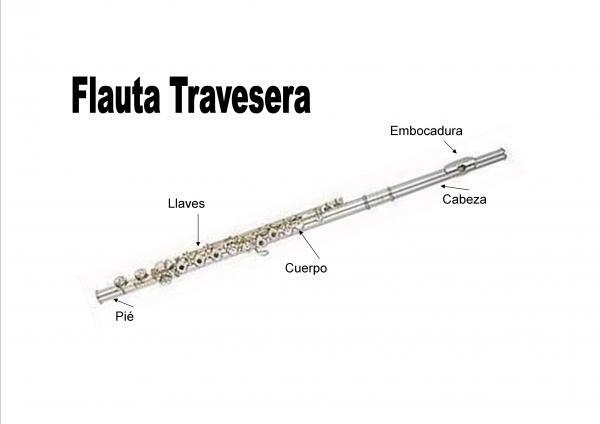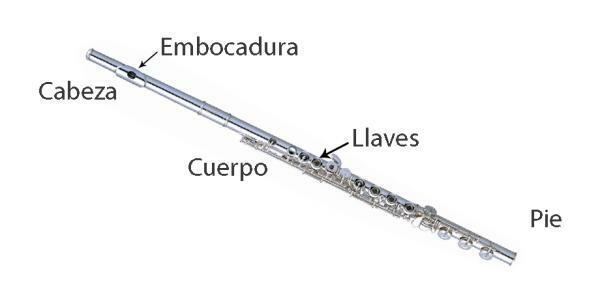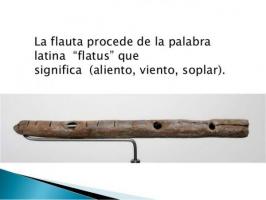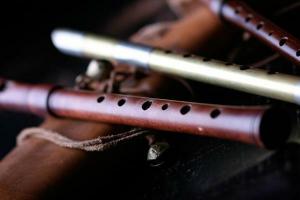All PARTS of the transverse FLUTE

Image: Beveled Stories
Thanks to the incredible variety of instruments that exist in music, we can create works with different timbres which together result in wonderful works. We achieve this thanks to the combination of tones and textures that allows us to explore the beauty of sound and its properties.
The shape, the material and the mechanisms are essential elements in an instrument to define that sound, after all, it has been designed to complete the realization of an idea. In this lesson from a TEACHER we will talk about a delicate sounding instrument: we will know the parts of the transverse flute.
The transverse flute (also called traversa or transversal) is a woodwind instrument (does not necessarily mean that it is made of this material) with metal body. Its parts that are assembled before playing and that are disassembled for storage. It is played with two hands horizontally and has keys that by means of mechanisms cover and release the holes in the instrument to produce the different notes.
Its origin comes from relatives of the recorder that have been evolving and changing. The transverse flute came to Europe from Asia in the eleventh century, At that time and in the centuries to come the recorder was much more popular and it was not until later that the transverse flute replaced it for symphonic purposes. The last design of the transverse flute, which is the one we know today, was made in the 19th century.
The transverse flute has a sweet sound and can perform both long-duration and short, nimble notes. It is used mainly in classical music for the symphony orchestra or chamber ensembles.
How the transverse flute works
Like other wind instruments, the transverse flute is designed to manipulate the passage of the wind through your body. The instrumentalist blows through a hole and then presses or releases the keys that with different combinations produce different notes. The sound is caused by the vibration of the wind inside the instrument and the changes of space and pressure in the instrument.
Similar to other wind instruments, the transverse flute works by means of bevel, which is a sharp, sloping cut in a surface against which the wind collides to produce sound. This part is inside the instrument.

Image: Slideshare
Let's get into the subject and get to know the parts of the transverse flute. As mentioned above, this instrument can be taken apart for storage and must be reassembled to be played. These parts are 3 main: head, body and foot. The parts that match and fit together to put the pieces together are called clamps, anchors or joints.
We should mention that the name of the parts sometimes changes depending on the region in the world, but they are essentially the same.
Head
It is the upper part of the flute, which contains the hole through which the instrumentalist blows. We call this hole, as in other instruments of a similar type mouthpiece. The mouthpiece has an attached metal piece, this piece is called lip. The embouchure requires a specific technique with the mouth to blow in a certain way and make the instrument sound the way it was designed. The end of the head is called Crown.
Body (or intermediate tube)
Among the parts of the transverse flute, this is the longest and the one with the most holes and pieces. In the body we find the following parts:
- Holes: Sometimes they are also called "chimneys" and this is where the air is expelled from the body of the instrument. Depending on the combination of holes that are covered, the note produced will be different.
- Keys: They are the pieces that are pressed with the fingers to cover the holes of the flute. There are two types of keys: hole open or closed. It also has levers, which do not directly cover the holes. As part of the mechanism we find the springs, which are small pieces that connect with each other to make the movement work.
- Keys have other parts underneath, springs and pads that protect the metal from shocks on the other side of the tube. Most braces are on the body, there are a few on the foot.
- Rib: It is a piece that unifies and holds all the keys on the flute.
Foot
And we finish with the parts of the transverse flute to talk about the foot. It is the furthest part of the flute and the shortest. The transverse flute is in C tuning, but this can be changed to B by substituting the foot for another.
Now that you know the parts of the transverse flute, you will have a broader knowledge of its operation and its way of being. If you have the opportunity, go to one so you can confirm what you have learned. If you are even more curious, you may want to encourage yourself to learn to play the transverse flute, this being a very melodic, expressive and versatile instrument.

Image: Wind Instruments



